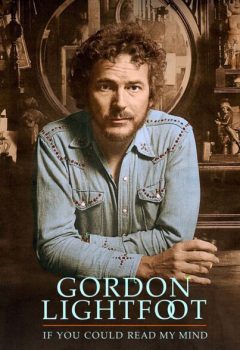Featured Stories
Gordon Lightfoot: If You Could Read My Mind
Film Review
Movies, the authentically good ones, have the ability to reflect the best and the worst in humanity. If done well, we witness the highs and lows of the journey of life. The 2019 documentary, Gordon Lightfoot: If You Could Read My Mind, is as revealing as it is entertaining in its portrayal of Canadian singer-songwriter Gordon Lightfoot’s rise from a young promising singer-songwriter to his emergence as a major iconic legacy artist, an international treasure embodied in one man.
In this film the open book of his life is presented with honesty as well as care allowing a rare glimpse of the angels and demons that drive one artist as he creates an unparalleled body of work. The film’s success hinges on the visionary cinematic realization, the archival sensibility and cohesive writing skill that directors Martha Keho and Joan Tosoni have infused in this superior documentary.
The effectiveness and engaging quality of this documentary also has a lot to do with the absolute openness of Gordon Lightfoot himself, who has dropped all pretense of mystery after several battles with heartbreak and near-death health concerns in recent decades.
If this were Citizen Kane the first frame would reveal just what Rosebud symbolized. There is no abiding mystery here. For Lightfoot, it’s present in his openness and the confessional way of telling his story that his brilliance as a singer-songwriter is clearly revealed. We don’t need to read his mind. All we need do is listen to his songs. His story is there from “Early Morning Rain,” to “The Wreck of the Edmund Fitzgerald.”
The film’s opening scenes tell all. Set in the present day on the eve of his 80th year, the songwriter is standing, center-frame in the doorway of his classic mansion home between two traveling chairs at his feet. He turns and opens the door and walks in. The camera pans to a sketch of Toronto’s Massey Hall, where, it is later shown, Lightfoot will perform later that evening. Then we see family pictures, children, ex-wives, and loves roll by. We see 80-year-old Lightfoot sitting and peering grudgingly at himself on the television in his black-and-white past, from some 60 years ago. With his wife, Kim, they watch a young Gordon performing “For Loving Me,” one of his early classic songs that was recorded by Ian & Sylvia, Peter, Paul & Mary, and Johnny Cash. Lightfoot cringes at the misogyny of the lyrics with words like, “I’ve had a hundred more like you, so don’t be blue, I’ll have a thousand before I’m through.” The song was written while he was married to a Swedish woman, Brita Ingegerd Olaisson. He was also the father of their two children. “How do you think Brita felt. I guess I just don’t like who I am,” he complains as he receives reassurance from his wife, Kim. She lovingly reminds him he is treasured by so many. “Turn this fucking thing off. I hate this song, Let’s move on,” he finally demands. But, from the look of disgust on his face and the vulnerability in his eyes, it is clear—he carries a sense of guilt and grief over the sorrow he has caused others in his life. Especially the women he has loved.
We then do move on to the story of a very young man who forges a historic place in the world of international folk music, managing to become a national success in Canada even as he breaks out in American and Europe as a premier folk singer and songwriter. He gains success in pop music and earns fans like Bob Dylan, Elvis Presley, and Barbara Streisand. All of them cover his songs.
Like the masterfully conceived haunting montage that follows the prelude, the film is a journey through time, impressions, history, nostalgic leanings, and moving stories of redemption. The end result shows what illuminates the possibilities inherent in the imagination of the songwriter and, most especially, this songwriter, who still sings “if you could read my mind” with such passion and vulnerability.
The film’s archival and editorial work, including audio and video clips from Lightfoot’s earliest childhood days, singing “The Lords Prayer” at church, his pre-career crooning in a barbershop quartet, his earliest television appearance as Canada’s most embarrassed square dancer on an obscure Canadian country music show, to early, grainy black-and-white glimpses of the DuoTones, his short-lived folkie Everly Brothers-inspired duo with Terry Whelan.
But once he goes solo, the speedy bullet train of his career is well chronicled with rare film footage and notable interviews punctuated by comments from Lightfoot. Along the way we hear of his impact and influence on people like Burton Cummings, Randy Bachman, Greg Graffin of Bad Religion, Alec Baldwin, Steve Earle, Anne Murray, Sarah McLachlan, and Ian and Sylvia Tyson.
The darker edges of his life are well chronicled with an interview with the unstable and what he describes as “dangerous” relationship with singer Cathy Evelyn Smith. She would spend time in prison after providing the late comedian, John Belushi, with his fatal drug overdose. She had such an impact on Lightfoot that he wrote his hit song “Sundown” about her with lyrics like:
I can see her lying back in her satin dress
In a room where you do what you don’t confess
Sundown, you better take care
If I find you been creeping ‘round my back stairs
But, it’s his health crisis, including a battle with alcoholism, a life threatening illness with an abdominal aortic aneurysm, and a stroke that reveal the strength of his character and the tenacity of his artistry. He recovered from all of them and returned to songwriting, recording, and performing with each battle. As of the onset of the 2020 pandemic, Gordon Lightfoot was still touring and recording.
As the film comes to an end, the message of the filmmakers and the Rosebud revealed is clear—the world has been a better place with Gordon Lightfoot in it. At the end of the present-day interview he is accepting of his life, his failures and successes.
As he returns to the stage at Massey Hall in Toronto for his 2019 concert for the filming of this documentary, he is once again adored by his audience. His performance is strong and carries the same signature passion he has been known for these last 60 years. While many documentary films about musical icons simply run down the events of the subject’s life, this film reveals and enlarges its subject with honesty and integrity.
As the credits roll, there is the sense that the legend of Gordon Lightfoot will continue beyond our present time. But just as strong is the sense that the reality, love, and truth he has brought to his life in song will live well beyond his sundown years…and ours. As the concluding title song plays out, we hear Gordon Lightfoot sing those familiar words with confidence and clarity even as he confesses the guilt he feels about the women in his life he has hurt. But, it’s in the wisdom of the song where the healing is still present, even as he sings, smiles, and leaves the stage into the darkness of the night and his final days. May they yet be a long time coming.











